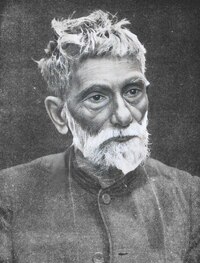Acharya Prafulla Chandra Ray
| Acharya Prafulla Chandra Rây | |
|---|---|
 |
|
| Born | Prafulla Chandra Rây 2 August 1861 Raruli, Khulna, Bengal Presidency, British India |
| Died | 16 June 1944 (aged 82) Calcutta, India |
| Nationality | Indian |
| Fields | Chemistry |
| Alma mater |
Metropolitan Institution Presidency College University of Calcutta Edinburgh University |
| Notable students |
Satyendranath Bose Meghnad Saha Jnanendra Nath Mukherjee Jnan Chandra Ghosh |
Acharya Sir Prafulla Chandra Rây CIE (Bengali: প্রফুল্ল চন্দ্র রায়; 2 August 1861 – 16 June 1944) was a Bengali chemist, educator and entrepreneur.
The Royal Society of Chemistry honoured his life and work with the first ever Chemical Landmark Plaque outside Europe. He was the founder of Bengal Chemicals & Pharmaceuticals, India's first pharmaceutical company. He is the author of A History of Hindu Chemistry from the Earliest Times to the Middle of Sixteenth Century (1902).
Rây was born in Raruli-Katipara, a village in the Khulna District of present-day Bangladesh. His father Harish Chandra Ray was a land proprietor. Up to the age of nine, Prafulla Chandra studied in a school in his village. In 1870 his family migrated to Calcutta and Rây and his elder brother were admitted to Hare School. In 1874, while Ray was in the fourth standard, he suffered from a severe attack of dysentery, which hampered his health throughout his life. Due to the severity of the attack, Ray had to postpone his studies for a couple of years and return to his ancestral home in the village. However Ray himself considered this disruption in his studies as a blessing in disguise as it allowed him to read much more widely than what would have been possible within the constraints of school curricula. Amongst others, he read Lethbridge's 'Selections from Modern English Literature' and Goldsmith's Vicar of Wakefield. After recovering from his illness, Ray returned to Calcutta and took admission in Albert School.
In 1879 he passed the Entrance Examination and took admission into the Metropolitan Institution (later Vidyasagar College) which was established by Pandit Ishwar Chandra Vidyasagar. At that time the Metropolitan Institution had no science classes or laboratories and Ray attended lectures on physics and chemistry in the Presidency College as an external student. Here he was specially attracted by the chemistry courses of professor Alexander Pedler. While studying for his BA examination, he applied for and was awarded in 1882 one of the two Gilchrist Prize Scholarships after an all-India competitive examination. Without completing the course for his degree, Prafulla Chandra proceeded to Britain and enrolled in the BSc programme of Edinburgh University where he studied physics, chemistry and biology amongst other subjects. But Ray did not confine his studies to only natural sciences. He also developed a strong interest in history and read books like Rousselet's L'Inde des Rajas, Lanoye's L'Inde contemporaine, Revue dex deux moneds. He also read Fawcett's book on political economy and Essays on Indian Finance. After obtaining his BSc degree from Edinburgh University, Ray embarked on his doctoral thesis (DSc) in the same university and completed his doctorate in 1887. He was awarded the Hope Prize which allowed him to work on his research for a further period of one year after completion of his doctorate. His thesis title was "Conjugated Sulphates of the Copper-magnesium Group: A Study of Isomorphous Mixtures and Molecular Combinations". While a student he was elected Vice-President of Edinburgh University Chemical Society in 1888.
...
Wikipedia
